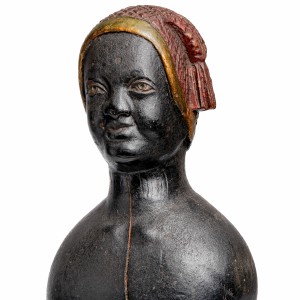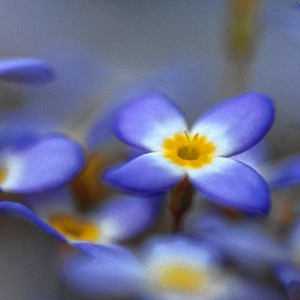A bright splash of color: Carle Museum tries on special glasses for visitors with vision issue
| Published: 03-02-2023 3:22 PM |
For Will Schneider, putting on this pair of glasses opened up his vision to a depth of color he wouldn’t ordinarily see.
“The blue is so much more textured,” said Schneider as he peered at an illustration at the Eric Carle Museum of Picture Book Art. “It’s just a whole lot more vivid and detailed. I can see brushstrokes that I missed [without the glasses].”
Schneider, who’s from Northampton, has been dealing with color blindness since he was a kid, a time when he remembers his mother asking him to sort M&Ms into piles: “I made three piles. But apparently there were five colors.”
But along with two other volunteers, Schneider came to the Carle Museum earlier this week to test out some EnChroma glasses — glasses that look like standard sunglasses but which enable most, though not all, people with color blindness to see an expanded range of colors.
The glasses, first created almost by accident about 15 years ago by a California scientist, Don McPherson, are now being made available to visitors to the Amherst museum — adults and children, for inside and outside use — who have difficulty differentiating between certain colors, or seeing some of them at all.
“We see this as part of our overall effort to be inclusive and accessible to everyone,” said Courtney Waring, the museum’s director of education.
The museum’s founder and namesake, the late Eric Carle, “was so inspired by nature and by color,” Waring said, “that he would have wanted people to appreciate the full range of colors in all the artwork in the museum, and outside in Bobbie’s Meadow” (the museum’s garden space, named for Carle’s late wife).
EnChroma, in Berkeley, California, has created an “Accessibility Program” for its glasses, selling sets of them to about 200 museums, universities, adventure outfitters, U.S. national parks and other places to lend to visitors.
Article continues after...
Yesterday's Most Read Articles
The Carle, Waring said, is the first museum in Massachusetts to make the glasses available to visitors. There are now eight pairs of them in stock, in different sizes and in some cases designed to fit over regular eyeglasses, which visitors can ask to borrow.
According to the EnChroma website and a number of news reports, McPherson, who has a Ph.D. in glass science and is the company’s co-founder and chief science officer, had originally created special eyewear for doctors to use as protection during laser surgery.
But through a number of means, McPherson discovered his glasses also made colors seem richer and more saturated; he subsequently did research on color blindness and applied for a grant from the National Institutes of Health to do further testing and development of the glasses.
To mark the debut of the product in Amherst, the Carle Museum reached out through its employees, volunteers and other contacts to find color blind people who’d be willing to test the glasses. That brought in Schneider, 41, who has a neighbor who works at the museum.
“I like the fact that the Carle is all about inclusion, even if [color blindness] isn’t on the same level as not having the use of your legs or something really serious,” said Schneider, who works in the nonprofit field. “It’s nice to see this richer range of colors.”
Schneider was joined by two other volunteers: Edward LeSage, 73, a retiree from Amherst, and Crow Boutin, 38, who came all the way from Kennebunkport, Maine.
Boutin, a hardwood wattle artist, says he’s always had good vision and can differentiate the wood he gathers in forests well enough. “But I wanted to see what I was missing,” he explained.
Fittingly enough, he, LeSage and Schneider first put on their EnChroma glasses for an exhibit of Carle’s work, “Eric Carle’s Book Birthdays.” Schneider was staring at an illustration from the story “Panda Bear, Panda Bear, What Do You See?” when the deep blues of the art fully came into view via the glasses.
“It’s so much richer and fuller,” he said.
LeSage checked out artwork from another book Carle illustrated, “Do Bears Have Mothers, Too?” He twisted the EnChroma eyewear a bit and angled his face so that he could look at the illustration with the glasses covering one eye but not the other.
“The difference is amazing,” he said. “Without the glasses the colors look kind of hazy and washed out … they’re certainly more intense with them.”
According to information the Carle and EnChroma made available, about 1 in 12 men and 1 in 200 women worldwide are color blind — or more accurately, color vision deficient. An estimated 13 million Americans are affected, including about 300,000 people in Massachusetts.
LeSage says he can have problems when he drives into an unfamiliar town at night because he’ll have trouble seeing the difference between the headlights of cars and the green “go” signal in a traffic light: “It can be a safety issue.”
Ironically, he noted, he’s an artist himself and previously worked in a business in which he cut and designed stained glass windows — but his partner, he said, had to select all the colors for the work.
“I’ve generally needed help in seeing the full range of colors,” LeSage said with a laugh.
Boutin, the Maine wood artist, stood looking at some of the artwork — his partner, Kehber Grier, had heard about the Carle program and convinced him to come to the museum. “This is awesome,” he said, “The colors just kind of leap out at you.”
He and the two other volunteers left with free pairs of the EnChroma glasses for volunteering to test them in the museum. “I’m looking forward to trying these out in the woods,” he said.
Steve Pfarrer can be reached at spfarrer@gazettenet.com.

 Painting a more complete picture: ‘Unnamed Figures’ highlights Black presence and absence in early American history
Painting a more complete picture: ‘Unnamed Figures’ highlights Black presence and absence in early American history Earth Matters: From Big Sits to Birdathons: Birding competitions far and near
Earth Matters: From Big Sits to Birdathons: Birding competitions far and near The Beat Goes On: Album release shows by Barnstar! and Lisa Bastoni, a Young@Heart Chorus concert with new special guests, and more
The Beat Goes On: Album release shows by Barnstar! and Lisa Bastoni, a Young@Heart Chorus concert with new special guests, and more Speaking of Nature: Indulging in eye candy: Finally, after such a long wait, it’s beginning to look like spring is here
Speaking of Nature: Indulging in eye candy: Finally, after such a long wait, it’s beginning to look like spring is here
